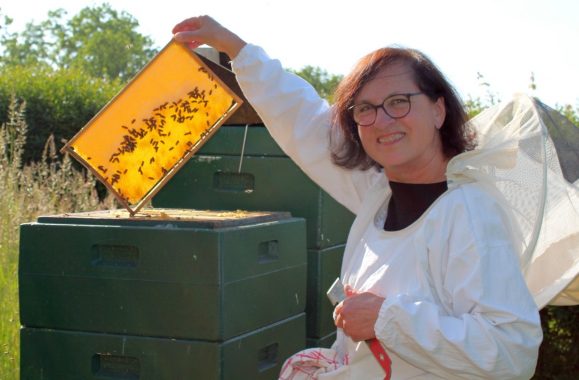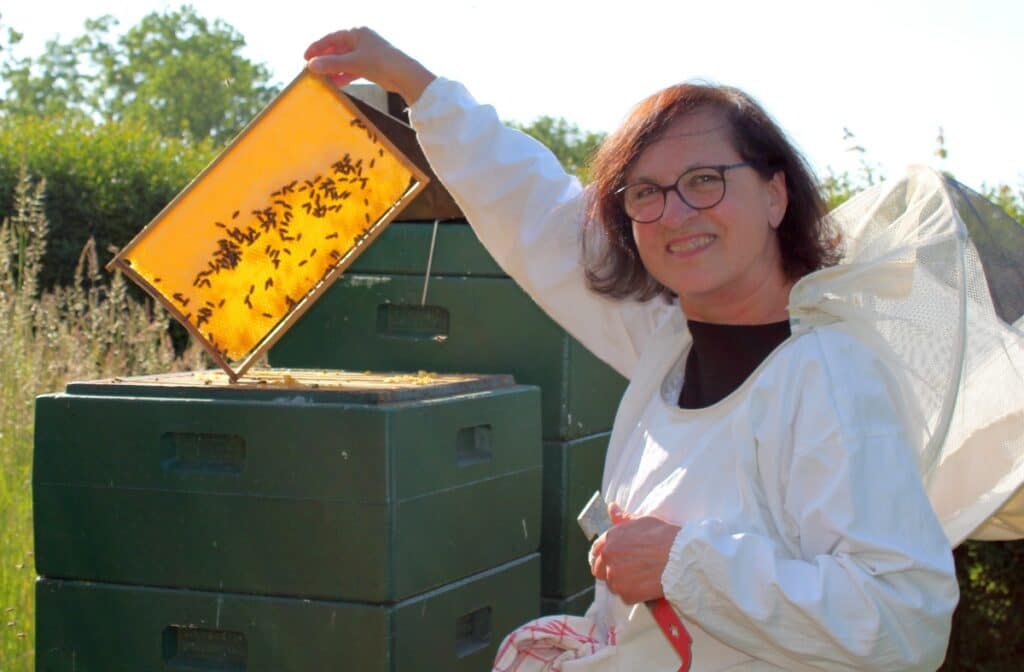
Honey - a feast for the senses!
How do beekeeping, Slow Food and a honey tasting complement each other?
The regional marketing of a Slow Food product, the variety of flavors in honey and the life of honeybees in climate change - these are just a few facets that are on Marianne Kehres mind as a beekeeper. Her initiative of marketing honey as a valuable regional product brings her to ‘Slow Food’ fairs in Italy and Germany sharing her expertise on bees and the wonderful flavors of honey. As a honey sommelier she shares with us her sensory description of honey, and how the versatile taste of honey compliments other food.
How do I become a sought-after bee and honey expert?
With close observation, courses and literature about bees & plants and the passion for the delicious taste of honey, Marianne works out her career path. In the beginning, there is the idea to let the old tradition of an insect-friendly kitchen and nature garden blossom again on her large property in the countryside near Cologne surrounded by meadows and forests. The trend 'huge lawn with a few tropical ornamental trees' does not correspond at all to Marianne's ecological idea. At the beginning she buys two bee colonies from the local beekeepers' association to pollinate the newly planted apple trees. With her contagious passion and curiosity for bees and their natural product, her male colleagues from the local beekeepers' association elect her for the position as the chairwoman after a year. She also inspires people at institutes and events as an expert on the subject of 'bees, beekeeping and honey'. With her advertising flyer directed at women, she manages to increase the number of female beekeepers in the traditional male domain. But her heartfelt theme is the fact that a female or male beekeeper, even with only one colony of bees, makes a valuable contribution to our ecosystem. And also, they experience an enriching activity throughout the year.
Where do I buy my honey?
If you go to Provence and let yourself be infatuated by the scent of the lavender fields or the yellow color impression of a sunflower field, you will certainly buy a jar of honey there. In the delicatessen or organic food store, names like 'orange blossom honey' from Spain, 'chestnut blossom honey' from Italy or 'Manuka honey' from Australia inspire us to buy some honey.
"Yes, varietal honeys are known and the taste is imaginable for most people. But that in most countryside 'forest and meadow honeys' exist which have a unique wonderful taste, that is not clear to most consumers. Imagine - they consist of a diverse mixture of different nectars and honeydew from flowers and plants which many people are not even aware off or don’t even know. The assortment of supermarkets often consists of only one brand. In Germany most ‘lovers’ of honey still buy this Slow Food product from their local beekeeper in the neighbourhood."
At the beginning of her career as a beekeeper Marianne convinces the supermarkets in her region to include the local honeys in their assortment. She gains high level recognition with her marketing initiative 'Buy Regional Honey’. A valuable ‘Slow Food’ product produced in the neighbourhoods. Another important point is also that the visibility of a product guarantees a small income for the beekeepers. But usually, it is the passion of each beekeeper that generates the energy to continue with this important work. The honey bees and the beekeepers generate the ecological diversity of nature and this an important and absolutely necessary action for us all.
What does Italian and French creativity & appreciation of food involve?
Who has eaten Parmesan or grilled goat cheese with a creamy, malty grape and apple tasting honey? Or enjoyed a lemongrass-scented white chocolate and vanilla flavored honey with a yogurt or vanilla ice cream? What honey flavor enhances a salad dressing? And what consistency and flavor should my breakfast honey have on sourdough farmers bred or a French baguette? In southern countries, the variety names of honeys already give a hint about the taste experience. Chestnut honey, lavender honey, mountain herb honey, orange blossom honey - these plant names appeal to our sensory imagination. We remember the smell of oranges or the taste of chestnuts. But what world of taste is hidden behind a German early harvest, summer blossom or forest honey? Only 'sweet' and 'slightly spicy' do not do justice to a 'forest and meadow honey' from an amazing source of plants.
Why are 'forest and meadow honeys' so diverse in taste?
"Plants honey differently depending on the weather condition. The pollen collected includes the taste of the different plants, but the same plant pollen is different due to the fact if it is too warm or cold, too damp or dry. So the harvest of the bees gives rise to color, odor and taste combinations in ever new variations. Just as nature, the season, the climate and the soil determine the natural process. Thus, no two honeys are alike! The fact that bee colonies collect their pollen on more than 50 km² also contributes to the taste diversity of the honeys."
With so many different flavors of plant flowers and honeydew, the result is a wonderful mix, but then how does this honey from spring and summer time taste? Through her 'Regional Marketing Project' Marianne receives an invitation to the Slow Food Fair 'Terra Madre' in Turin, Italy. There, the best honeys are awarded prizes. She is impressed by the fact that honey is presented and described in terms of taste like wines. This is an inspiration for Marianne. She develops a scheme for a honey bonitur, a systematic sensory description of honeys. This though out description gives the beekeepers a possibility to inspire their costumers with this special Slow Food product. And Marianne also includes a recommendation how the flavors of this particular honey compliments another food – cheese, yoghurt, sweet or savory. She is truly a honey sommelier. What is possible for wine is of course possible for honey.
How does Marianne work as a honey sommelier?
It takes time to get to the bottom of a honey's flavor. A teaspoon of honey mixed with water, covered in a large glass, reveals additional flavor nuances after a resting period. As with wine tasting, no more than 4- 6 honeys can be tasted at once.
"The appearance and color already give an indication of where the bees collected the nectar. When opening the jar, the first sensory impressions already reach us via the diverse smell. When the honey then reaches the tip of the tongue in the throat, the aroma substances warm up and also reach the receptors of the nose. Thus, all these sensory impressions open up the world of unique tastes – showcasing the diverse nature sources. So ‘honey’ is really much more than just sweet or fruity."
But which vocabulary does justice to the unique taste of honey? Marianne lists the most important components in her aroma wheel. First, we perceive the smell, then the consistency of the honey with its mouthfeel. After these initial sensory classifications, Marianne differentiates the taste into areas: sweet, sour, salty, bitter and umami. This is followed by the multitude of fascinating aromas. The conclusion, as in wine tasting, is the finish. Marianne uses her methodology to develop flavor descriptions for the honeys submitted to the ‘German Bee Institute’. Beekeepers use the institute for purity and pollen analysis of their honeys. With Marianne's 'tasted' flavors and recommendations, beekeepers have another feature at their disposal to be used as a marketing tool.
Beekeeping - coincidence or perhaps predestination?
When Marianne starts her natural garden, her Slow Food mission is not yet present. Going along she buys an old wooden trailer which always belonged to a beekeeper in the old days. Now she uses the trailer as a small private beekeeping museum. There a late-found old family photo shows her family. They were beekeepers over a 100 years ago. Sometimes the passion skips a few generations. In keeping with that era, there's a honey extractor and old beehives made of straw and smeared with cow manure, billboards, beekeeping tools and Marianne's work clothes - a beekeeper's hat and her loose-fitting beekeeping blouse.
"I usually go without this protection to my bee colonies, which are almost all very peaceful. Stings still occur on rare occasions. But then it's usually my fault."
How does the climate change influence the honey production?
As a bee expert, Marianne participates in various scientific projects. After the bee die-off in the early 2000s German institutes started with collecting data from selected beekeepers. Also, the unpredictable weather of the last few years show that there are no reliable predictions about the amounts of honey production. A scale on her hive measures the bees' honey production based on the weather and delivers the data right away.
"Until April, colder weather signals the queens not yet to start maximum egg production. Then, when the sudden onset of very warm spring weather causes nature to develop very quickly, there often aren't enough honey bees to do their job yet. If the summer is then too dry, the bees may satisfy their search for food and thirst with the juice of fruits, thus bringing fruit juice instead of nectar into the hive. This is an observation that did not exist a few years ago. In such a case, the quality of the honey must be checked and ensured in the laboratory."
What does a bee-friendly garden look like?
Apple trees, raspberry bushes, old forgotten crops such as the farmer's leek loved by bees, many flowering herbs, natural meadow areas and plants blooming in many colors offer Marianne's bee colonies a great variety. But only a small portion of her 25 colonies are at the edge of her garden. During the busiest time for bees, more than 25,000 flying bees buzz through forests and meadows in the different areas in country side around her garden – as far as 25 km away.
At the end of a year, more than 2000 jars of honey with different flavors are for sale. Inspired by Marianne's descriptions, the choice is not difficult for the costumers - whether for breakfast or with cheese or a dessert. Honey lovers already know: each honey offers us a feast for our senses.

Name: Marianne Kehres
She is:
Beekeeper, honey and bees expert.
now a so-called pensioner, inquisitive, questioning, always working and happy (I had luck, she says).
She can be found in: the countryside, 30 km east of Cologne.
She likes:
_ her garden and her beautiful life
_ unadulterated dishes of good quality and red wine.
_ northern Germany with the wind, a stroll through Lüneburg, the Emigration House and the Climate House in Bremerhaven, the Weser Cycle Path from Hannoversch Münden to Cuxhaven
_ today's youth with a healthy self-confidence.
She admires:
Vandana Shiva from India for her commitment to biodiversity and organic farming.
Her WIASOLA Tip:
Why don't you ask people in your personal environment about their life story when the opportunity arises? Every differently lived life path is so exciting, admirable and enriching for you.
Your 3 favorite books:
_ 'Food Monopoly' by Ann-Helen Meyer von Bremen and Gunnar Rundgren.
_ 'Old Country' by Dörte Hansen
_ 'Polninken or a German love' by Arno Surminsk
Her favorite music:
_ the piano music of Frederic Chopin 'The Chopin Album' played by Lang Lang.
To be found: